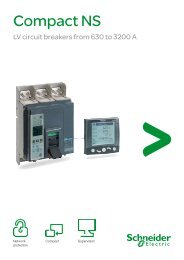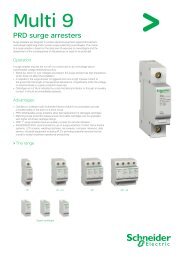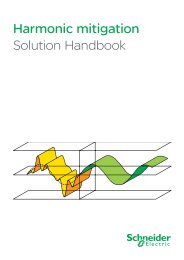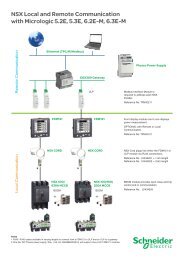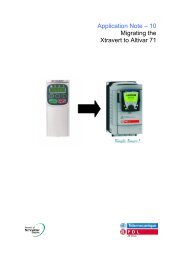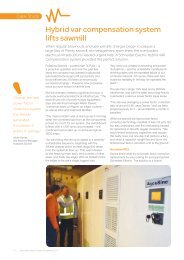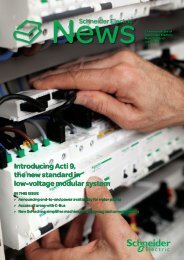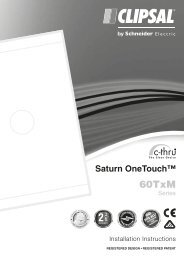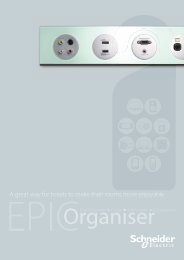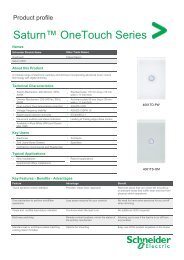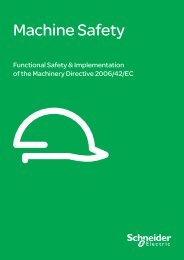Prisma Plus - error
Prisma Plus - error
Prisma Plus - error
Create successful ePaper yourself
Turn your PDF publications into a flip-book with our unique Google optimized e-Paper software.
Busduct offers<br />
more flexibility<br />
When the designers of Auckland<br />
University’s new Centre for<br />
Advanced Composite Materials<br />
Research began planning its wiring<br />
system, they knew ongoing ‘change’<br />
would be a key requirement – so<br />
they elected to use Schneider<br />
Electric’s Canalis technology.<br />
The Canalis Busduct. Supplys power to the machines below is<br />
simply a matter of inserting a tap off box – situated on both<br />
sides of the busduct – and dropping an electrical feed.<br />
The Research Centre is part of the<br />
University’s Mechanical Engineering<br />
Department, and is located at Auckland<br />
University’s Tamaki Campus. Geared to<br />
the research of a wide variety of<br />
composite materials, the facility houses<br />
a diverse array of machinery.<br />
It includes hydraulic presses, plastic<br />
injection moulders, extruders and ovens,<br />
as well as the standard range of lathes,<br />
milling machines and general workshop<br />
equipment.<br />
“Our new building is a marvellous, openplan<br />
design that lets in plenty of natural<br />
light,” says the Centre’s Technical Officer,<br />
Rex Halliwell “but we knew that providing<br />
three-phase power to the machines was<br />
going to be an issue. For a start, there<br />
are no vertical support columns, so there<br />
are no obvious routes for electrical<br />
conduits – or for getting power to the<br />
centre of the building.<br />
“Perhaps more significantly, this is a<br />
research centre, and by its very nature,<br />
we are continually adding new<br />
machines to the inventory. That means<br />
we are often moving machines around<br />
to make better use of space and ‘flow’<br />
though the facility. With conventional<br />
wiring, that would require plenty of<br />
rewiring and re-connecting.”<br />
Collectively, he points out, the machines<br />
also draw a substantial load. “All in all,<br />
a conventional wiring system would be<br />
a problem. Our consulting engineers,<br />
Sinclair Knight Mertz, specified the<br />
Canalis Busduct system. It overcomes<br />
all those issues – and it works superbly.”<br />
The facility’s electrical infrastructure<br />
features four, parallel busducts running<br />
the length of the building, mounted<br />
above I-beams or suspended from the<br />
ceiling. The busducts have different<br />
amperage ratings: one each of 800A,<br />
500A, 200A and 100A.<br />
Providing power to machines is simple,<br />
says Halliwell.<br />
“We insert a tap-off box into the<br />
overhead trunk busduct at the closest,<br />
convenient point, and just drop a cable to<br />
the machine. The tap-off boxes are selfcontained,<br />
off-the-shelf items with built-in<br />
circuit breakers. They can be fitted to<br />
either side of the busduct, in designated<br />
centres about 600 mm apart.”<br />
Apart from the ease of connection, he<br />
says, moving a machine and its power<br />
source is simply a matter of unplugging<br />
the tap-off box and moving it to the new,<br />
appropriate take-off point along the<br />
busduct. “There is no climbing around,<br />
no re-routing cables, no disconnection.<br />
It gives us remarkable flexibility.”<br />
Single-phase power is also supplied<br />
easily. “We simply take the supply – at<br />
whatever overhead point is convenient –<br />
from one of the phases in the busduct.”<br />
The Telemecanique Canalis system<br />
was installed by Allendale Electrical,<br />
and project manager Bob Lawton says it’s<br />
far easier to fit than conventional wiring.<br />
“The pre-manufactured sections clip<br />
together – it’s a bit like Lego – and as<br />
they’re relatively light, they’re easy to<br />
handle. It’s much easier than routing<br />
cables within ladder trays, around<br />
corners and down to switchboards<br />
– so it’s much faster.”<br />
He says a major advantage of the<br />
busduct system is the freedom it gives<br />
the end-user for future expansion.<br />
“They’ve plenty of flexibility for rearranging<br />
their facility into any<br />
configuration they choose.”<br />
The Canalis Busduct trunking system<br />
is designed for different ratings: low<br />
distribution and medium power<br />
distribution.<br />
Low power distribution<br />
- Canalis KN (40 to 100A)<br />
There are two low power versions:<br />
• Canalis KNA – four live conductors<br />
(3L + N + PE) for distribution up to 100A.<br />
• Canalis KNT – identical to the KNA,<br />
but fitted with a remote transmission<br />
bus with three 2.5 mm2 conductors.<br />
KNA and KNT busduct trunking provides<br />
IP 41 protection or IP54 with accessories.<br />
A wide range of tap off units to service<br />
power and light outlets either protected<br />
and non-protected are available.<br />
Medium power distribution - Canalis KS<br />
Designed for high tap-off density in<br />
industrial and commercial buildings<br />
(exhibition halls, hypermarkets, and office<br />
blocks).The range is available in seven<br />
ratings, from 100 to 800A.The standard<br />
IP 52 protection makes KS suitable for<br />
the majority of locations. It can be<br />
increased to IP 54 by the addition of dust<br />
and damp-proof blanking plates on the<br />
tap-off outlets. A wide range of tap off<br />
units either protected and non-protected<br />
are available, rated from 25 to 400A.<br />
There are four busducts running the length of the facility.<br />
Some are mounted on an I-beam – others are suspended from<br />
the roof.<br />
For more information, contact:<br />
Ross de Bueger<br />
Applications Engineer<br />
Industrial Control & Low Voltage<br />
Schneider Electric (NZ) Limited<br />
PO Box 15 355<br />
Auckland<br />
Tel: 09 829 0679




